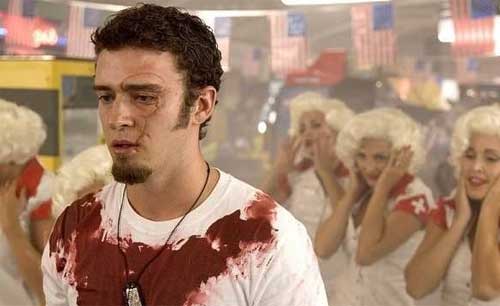Title: The Shallows
Director: Jaume
Collet-Serra
Released: 2016
Starring: Blake
Lively, Oscar Jaenada, Brett Cullen, Sedona Legge, Angelo Jose Lozano
Corzo, Jose Manuel Trujillo, Pablo Calva, Diego Espejel, Janelle
Bailey
Plot: Struggling to
deal with the loss of her mother to cancer medical student Nancy
(Lively) travels to the same secluded beach in Mexico her mother had
visited. However when she is attacked by a large great white shark,
she finds herself stranded 200 yards from the shore while being
stalked by the relentless shark.
Review: Director
Jaume Collet-Serra really is a director whose work its hard to place
as while he’s given us films such as “Orphan” and “Non-Stop”
he’s also the same director responsible for giving us the likes of
“Goal 2: Living The Dream” and the “House of Wax” remake
which so memorably was sold on the prospect of seeing Paris Hilton
die. As such your never really sure what your going to get from him
and while the concept and trailer for the film really gave it all the
potential of being another disposable summer release this film
thankfully really isn’t.
Stripping the film
down to its key elements here Collet-Serra really crafts something
surprisingly special as he seemingly knows that the real heart of the
film lies in the battle between Nancy and the shark currently
standing between her and the shore... and that’s essentially it.
This is also what appealed to Lively who was drawn to the project
when she saw the similarities between this film and her husband Ryan
Reynolds “Buried”.
True it might be a
big shark which continually torments Nancy but this at the same time
this isn’t some gigantic creature with super intelligence, which
makes this already miles better than the countless shark movies which
have continually attempted and failed to top what Steven Spielberg
achieved with “Jaws”. The shark here instead is designed with a
much more natural behaviour for the most part with Collet-Serra
really only letting it off the leash in the build up to the finale.
As such the shark only attacks Nancy initially when she stumbles into
its hunting ground, while her injuries only serve to maintain its
interest in her.
Despite the fact
that Blake Lively has hardly set my world on fire with her previous
performances which always felt that she was getting by on just being
the token pretty girl rather than anything resembling dramatic talent
and yet she is fantastic here, especially when its a role that
requires her to act by herself for about 90% of the film though she
does get a seagull (nicknamed Steven Seagull by Lively) to chat with.
While this sounds like kind of a drag here it actually works as we
get scenes such as Nancy treating any time she has to perform first
aid on herself like she is treating a patient, which sees her talking
her way through each procedure which largely consist of short term
solutions she can cobble together on the fly.
Seeing how Nancy
only has her wet suit, jewellery and a strap from her obliterated
surfboard to help her, its fascinating to see how she deals with a
situation which only continues to get worse for her especially with
the clock continually ticking down to high tide. This of course means
we do get some cringy moments such as her pinning a leg wound
together using earrings and her necklace and it surprised me to see
how willing Lively was to play a character who is essentially
brutalised by the elements for the film, especially when she does all
her own stunt work here outside of the few moment of surfing which
were handled by pro surfer Isabella Nichols who also taught Lively
some of the surfing basics such as how to Wax the board and attach a
leg rope to give it more of an air of authenticity.
Outside of the
survival aspect of the story we also get brief asides to her family
as her father questions her decision to drop out of medical school
after her mothers death, while her younger sister only further
cements the impression we get of her home life. We also get passing
interactions with a pair of fellow surfers and her local guide which
while they serve to provide potential saviours for her its soon clear
that its going to fall to Nancy to get herself out of the situation.
By keeping the shark
for the most part for the final quarter it really helps build a sense
of creeping dread throughout the film. At the same time while it
might be a CGI shark it is still miles ahead of the phoney looking
CGI that the Asylum / Sci-fi have been lumbering their productions
with and it makes for an effective threat by the production not
skimping on this element, especially as we all know how a cheap
effect can quickly deflate a production of any tension gained in its
build up.
One of the big
surprises of the 2016 release schedule this is a film certainly worth
seeking out, especially for Shark movie fans left craving the same
kind of thrills that “Deep Blue Sea” delivered. At the same time
its tight plotting and brief run time stop it outstaying its welcome
or becoming too outlandish.

































